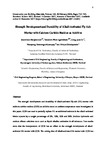Strength Development and Durability of Alkali-Activated Fly Ash Mortar with Calcium Carbide Residue as Additive
| dc.contributor.author | Li, Long-yuan | |
| dc.date.accessioned | 2018-01-17T09:00:32Z | |
| dc.date.available | 2018-01-17T09:00:32Z | |
| dc.date.issued | 2018-02-20 | |
| dc.identifier.issn | 0950-0618 | |
| dc.identifier.issn | 1879-0526 | |
| dc.identifier.uri | http://hdl.handle.net/10026.1/10600 | |
| dc.description.abstract |
The strength development and durability of alkali-activated fly ash (FA) mortar with calcium carbide residue (CCR) as additive cured at ambient temperature were investigated in this paper. CCR was used to partially replace FA as additional calcium in the alkali-activated binder system by a weight percentage of 0%, 10%, 20% and 30%. Sodium hydroxide and sodium silicate solutions were used as liquid alkaline activation in all mixtures. Test results show that the incorporation of CCR has an effect on the strength development of alkali-activated FA mortar with CCR. The setting time of alkali-activated FA mortar with CCR has decreased whereas its strength development has increased. This is further confirmed by XRD, SEM, and FTIR analyses, which show that the reaction products were increased when the alkali-activated FA incorporated with CCR. The highest 28-day compressive strength of alkali-activated FA mortar was found in the mix of 70% FA and 30% CCR, which is about 40.0 MPa. In addition, the resistances of alkali-activated FA mortar incorporated with CCR to tap water, 5% H2SO4 solution, and 5% MgSO4 solution are found to be superior to those of alkali-activated FA mortar without CCR as indicated by the relatively low strength loss. For the samples immersed in 5% H2SO4 solution and 5% MgSO4 solution for 120 days, the alkali-activated FA incorporated with 30% CCR showed a low strength reduction of around 71% and 53%, respectively. | |
| dc.format.extent | 714-723 | |
| dc.language | en | |
| dc.language.iso | en | |
| dc.publisher | Elsevier | |
| dc.subject | Alkali-activated Fly ash | |
| dc.subject | Calcium carbide residue | |
| dc.subject | Strength development | |
| dc.subject | Microstructure | |
| dc.subject | Durability | |
| dc.title | Strength Development and Durability of Alkali-Activated Fly Ash Mortar with Calcium Carbide Residue as Additive | |
| dc.type | journal-article | |
| dc.type | Journal Article | |
| plymouth.author-url | https://www.webofscience.com/api/gateway?GWVersion=2&SrcApp=PARTNER_APP&SrcAuth=LinksAMR&KeyUT=WOS:000425564400069&DestLinkType=FullRecord&DestApp=ALL_WOS&UsrCustomerID=11bb513d99f797142bcfeffcc58ea008 | |
| plymouth.volume | 162 | |
| plymouth.publication-status | Published | |
| plymouth.journal | Construction and Building Materials | |
| dc.identifier.doi | 10.1016/j.conbuildmat.2017.12.034 | |
| plymouth.organisational-group | /Plymouth | |
| plymouth.organisational-group | /Plymouth/Faculty of Science and Engineering | |
| plymouth.organisational-group | /Plymouth/Faculty of Science and Engineering/School of Engineering, Computing and Mathematics | |
| plymouth.organisational-group | /Plymouth/REF 2021 Researchers by UoA | |
| plymouth.organisational-group | /Plymouth/REF 2021 Researchers by UoA/UoA12 Engineering | |
| plymouth.organisational-group | /Plymouth/Research Groups | |
| plymouth.organisational-group | /Plymouth/Research Groups/Marine Institute | |
| plymouth.organisational-group | /Plymouth/Users by role | |
| plymouth.organisational-group | /Plymouth/Users by role/Academics | |
| dcterms.dateAccepted | 2017-12-06 | |
| dc.rights.embargodate | 2018-12-15 | |
| dc.identifier.eissn | 1879-0526 | |
| dc.rights.embargoperiod | Not known | |
| rioxxterms.funder | European Commission | |
| rioxxterms.identifier.project | Partnership for Research in Geopolymer Concretes | |
| rioxxterms.versionofrecord | 10.1016/j.conbuildmat.2017.12.034 | |
| rioxxterms.licenseref.uri | http://www.rioxx.net/licenses/all-rights-reserved | |
| rioxxterms.licenseref.startdate | 2018-02-20 | |
| rioxxterms.type | Journal Article/Review | |
| plymouth.funder | Partnership for Research in Geopolymer Concretes::European Commission |


